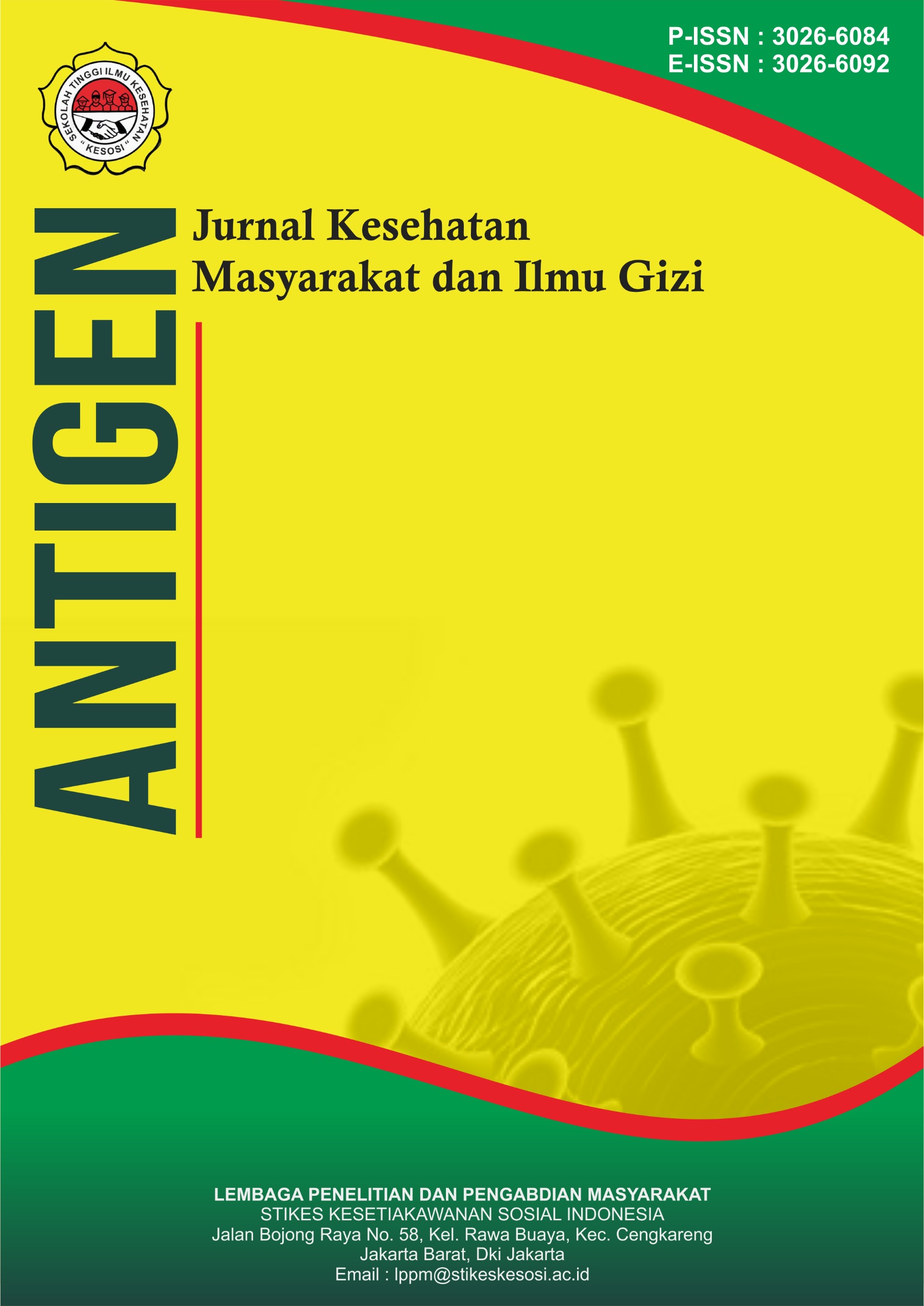Efektivitas Edukasi Bahaya Pergaulan Bebas dan HIV/AIDS pada Siswa MTSN 1 Konawe Selatan
DOI:
https://doi.org/10.57213/antigen.v3i3.759Keywords:
HIV/AIDS, Promiscuity, SchoolsAbstract
Adolescents are classified as an age group vulnerable to various health and social issues, including engagement in promiscuous behavior, which is considered to carry a high risk of HIV/AIDS transmission. According to national data from 2022, Southeast Sulawesi was ranked 29th with a total of 1,516 reported cases of HIV/AIDS. In Kendari City, 272 new cases were recorded from January to November 2022. Meanwhile, in South Konawe Regency the site of this study 9 HIV cases were reported in 2023 and 5 cases in 2024. This study was conducted with the aim of improving students’ knowledge regarding the dangers of promiscuity and HIV/AIDS through the implementation of educational activities carried out at MTSN 1 South Konawe. The method employed in this study was a quantitative approach using a pre-experimental design, specifically a one-group pretest-posttest design. The population of this study consisted of 30 students from grades VII and VIII at MTSN 1 South Konawe in the year 2025. The sampling technique used was purposive sampling, with a total of 30 respondents selected. Data were collected using questionnaires administered to respondents before and after an educational session was delivered using the interactive educational game "True-False". The data were analyzed using a paired test. Based on the results of the study, it was found that the “True-False” educational game had a significant impact on improving students’ knowledge, attitudes, motivation, and actions regarding promiscuity and HIV/AIDS. This was indicated by the p-values for knowledge (0.000) < α (0.05), attitude (0.000) < α (0.05), student motivation (0.000) < α (0.05), and student action (0.000) < α (0.05).
References
Adyani, K. (2025). Literature review: Pengaruh edukasi kesehatan terhadap pemahaman remaja mengenai HIV infection/AIDS. Jurnal Kesehatan Remaja, 5(2), 1485–1492.
Afrina, Y., & Salsabilla, D. A. (2024). Edukasi bahaya pergaulan bebas pada remaja di SMA Kristen Kota Palangka Raya. Compromise Journal: Community Professional Service Journal, 2(3), 7–12. https://doi.org/10.57213/compromisejournal.v2i3.280
Bukoting, M. F., & Mabonggin, A. (2020). Dampak pergaulan bebas. Pendidikan Islam dan Budi Pekerti, 1, 24.
Dewi, N., & Mesa, K. (2025). Pendidikan kesehatan terhadap peningkatan pengetahuan tentang HIV/AIDS pada remaja. Joting: Journal of…, 7(1), 15–23. https://doi.org/10.31539/joting.v7i1.14148
Afrina, Y., & Salsabilla, D. A. (2024). Edukasi bahaya pergaulan bebas pada remaja di SMA Kristen Kota Palangka Raya. Compromise Journal: Community Professional Service Journal, 2(3), 7–12. https://doi.org/10.57213/compromisejournal.v2i3.280
Lestari, H. (2024). Distribusi spasial dan analisis epidemiologi HIV/AIDS di Provinsi Sulawesi Tenggara. Jurnal Epidemiologi & Kesehatan Masyarakat Sultra, 3(2), 78–89.
Lubis, A. F., Gany, R., Sakti, G. P., Lestari, N. A., Arief, M., & Qudsi, A. (2022). Penguatan pendidikan karakter melalui edukasi bahaya pergaulan bebas pada usia remaja di SMA Negeri 3 Tangerang Selatan. Seminar Nasional Pengabdian Masyarakat LPPM UMJ, 2, 12–20.
Mbayang, C. M. (2024). Pergaulan bebas di kalangan remaja. JLEB: Journal of Law, Education and Business, 2(1), 366–372. https://doi.org/10.57235/jleb.v2i1.1669
Nisa Azkia, N., et al. (2024). Prosiding Pertemuan Ilmiah Nasional Penelitian & Pengabdian Masyarakat IV. Prosiding PIN PEMAS IV, 4(1), 663–624.
Pratama, R., & Majid, R. (2025). Pencegahan HIV dan AIDS pada remaja di SMA Negeri 10 Kendari: The relationship between knowledge and attitude with efforts to prevent HIV and AIDS in adolescents at Public High School 10 Kendari. Jurnal Edukasi Remaja, 5(4), 183–188.
Rasiman, N. B., & Rumbo, H. (2025). Peningkatan pengetahuan remaja tentang pencegahan dan penyebaran HIV/AIDS. Jurnal Kesehatan & Remaja, 9(1), 9–12.
Sembiring, L. N. B. (2022). Gambaran pengetahuan remaja tentang pencegahan penularan HIV/AIDS pada kelas XI dan XII di SMA Santo Antonius Padua. SBY Proceedings, 95–103.
Sumakul, V. D. O., Lariwu, C. K., Langingi, A. R. C., Tinggi, S., Kesehatan, I., & Tomohon, G. M. (2023). Pentingnya pencegahan penyakit HIV/AIDS pada remaja. Jurnal Pengabdian Kepada Masyarakat MAPALUS STMKGMT, 1(2), 45–53.
Suprayitna, M., Fatmawati, B. R., & Albayani, M. I. (2022). Gambaran pengetahuan dan sikap remaja tentang HIV/AIDS di Pondok Pesantren Assulami Lombok Barat. Jurnal Ilmiah STIKES Yarsi Mataram, 10(2), 17–22. https://doi.org/10.57267/jisym.v10i2.65
Sianturi, Y., & Malau, M. (2021). Buku ajar HIV/AIDS. Jurnal Informasi, Perpajakan, Akuntansi, dan Keuangan Publik, 16, 326–335.
Downloads
Published
Issue
Section
License
Copyright (c) 2025 Antigen : Jurnal Kesehatan Masyarakat dan Ilmu Gizi

This work is licensed under a Creative Commons Attribution-ShareAlike 4.0 International License.






